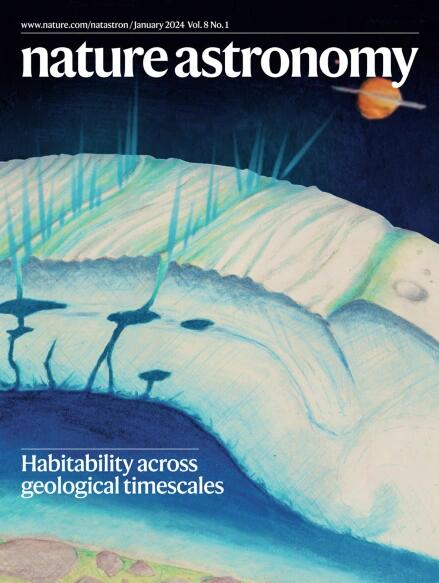6.45 h周期相干无线电瞬变脉冲的互脉冲发射
IF 12.9
1区 物理与天体物理
Q1 ASTRONOMY & ASTROPHYSICS
引用次数: 0
摘要
长周期射电瞬变是一类新的天文天体,其特征是长周期从18分钟到54分钟不等。它们表现出高度极化、相干、持续时间仅为10-100秒的射电发射。这些天体的内在性质有待推测,高度磁化的白矮星和中子星是主要的候选者。这里我们提出了ASKAP J183950.5−075635.0,拥有该类中已知最长的6.45 h。它表现出有序偶极磁场的发射特征,具有类似脉冲星的明亮主脉冲和较弱的互脉冲偏移约半个周期,这表明它是一个倾斜或正交的旋转体。这种现象是在一个长周期的无线电瞬变中观察到的,证实了无线电发射来自两个磁极,并且观察到的周期与旋转周期相对应。ASKAP J183950.5−075635.0的光谱和偏振特性与中子星起源一致,这一天体是我们理解长周期射电源及其与中子星联系的关键证据。本文章由计算机程序翻译,如有差异,请以英文原文为准。


The emission of interpulses by a 6.45-h-period coherent radio transient
Long-period radio transients are a new class of astronomical objects characterized by prolonged periods ranging from 18 min to 54 min. They exhibit highly polarized, coherent, beamed radio emission lasting only 10–100 s. The intrinsic nature of these objects is subject to speculation, with highly magnetized white dwarfs and neutron stars being the prevailing candidates. Here we present ASKAP J183950.5−075635.0, boasting the longest known period of this class at 6.45 h. It exhibits emission characteristics of an ordered dipolar magnetic field, with pulsar-like bright main pulses and weaker interpulses offset by about half a period that are indicative of an oblique or orthogonal rotator. This phenomenon, observed in a long-period radio transient, confirms that the radio emission originates from both magnetic poles and that the observed period corresponds to the rotation period. The spectroscopic and polarimetric properties of ASKAP J183950.5−075635.0 are consistent with a neutron star origin, and this object is a crucial piece of evidence in our understanding of long-period radio sources and their links to neutron stars. Coherent radio emission with a long (nearly 6.5 h) period has been detected from both magnetic poles of a rotating compact object, offering insights into the evolution and emission mechanism of compact radio transients.
求助全文
通过发布文献求助,成功后即可免费获取论文全文。
去求助
来源期刊

Nature Astronomy
Physics and Astronomy-Astronomy and Astrophysics
CiteScore
19.50
自引率
2.80%
发文量
252
期刊介绍:
Nature Astronomy, the oldest science, has played a significant role in the history of Nature. Throughout the years, pioneering discoveries such as the first quasar, exoplanet, and understanding of spiral nebulae have been reported in the journal. With the introduction of Nature Astronomy, the field now receives expanded coverage, welcoming research in astronomy, astrophysics, and planetary science. The primary objective is to encourage closer collaboration among researchers in these related areas.
Similar to other journals under the Nature brand, Nature Astronomy boasts a devoted team of professional editors, ensuring fairness and rigorous peer-review processes. The journal maintains high standards in copy-editing and production, ensuring timely publication and editorial independence.
In addition to original research, Nature Astronomy publishes a wide range of content, including Comments, Reviews, News and Views, Features, and Correspondence. This diverse collection covers various disciplines within astronomy and includes contributions from a diverse range of voices.
 求助内容:
求助内容: 应助结果提醒方式:
应助结果提醒方式:


